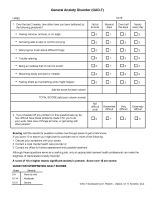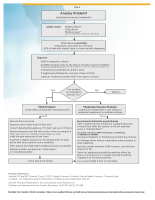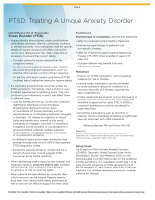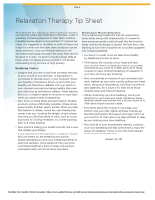Introduction and Overview
The following resources are widely used in clinical settings to screen and assess, design treatment protocol, prescribe medication and provide referrals for children and adolescents with symptoms of anxiety.
Screening & Assessment
A guide to design treatment protocol for a patient with anxiety symptoms.
 General Anxiety Disorder GAD-7
General Anxiety Disorder GAD-7
A popular anxiety screening tool appropriate for adolescents, young adults, and adults.
Treatment
Evidence-Based Treatments for Anxiety Disorders
Treating a Unique Anxiety Disorder
Breathing Control and Progressive Muscle Relaxation
UW Medicine’s Harborview Medical Center offers CBT for Anxiety handouts, worksheets, and resources. Cognitive Behavioral Therapy (CBT) is a leading treatment for anxiety.
Therapist Aid offers various anxiety tools to use with children.
Referral and Co-Management
NA for this topic
Medication
Fluoxetine (Prozac)
- Comes in: 10,20,40 mg (capsule; only 10 is tablet); liquid 20mg/5ml
- Start at: 5 or 10 mg
- Titration schedule to effect: 5, 10, 20, 30, 40; one step every 1-2 weeks until 20 mg; then increase at 1 month intervals because of time to efficacy.
- Most common dose range: 20-40 mg; max is 60 mg (if titrate to 60 with no effect – time to switch or refer to psychiatry)
- FDA approved for MDD (age 8); for OCD, age 7)
Children <7 years: Limited data available: Oral: Initial: 5 mg once daily (Gleason 2007).
Children ≥7 years and Adolescents: Oral:
Lower weight Children: Initial: 10 mg once daily; if needed, may increase dose after several weeks; usual daily dose: 20 to 30 mg/day; minimal experience with doses >20 mg/day; no experience with doses >60 mg/day.
Higher weight Children and Adolescents: Initial: 10 mg once daily; increase dose to 20 mg once daily after 2 weeks; may increase dose after several more weeks, if needed; usual daily dose: 20 to 60 mg/day
Sertraline (Zoloft)
- Comes in: 25, 50, 100 mg tabs; liquid 20 mg/1ml
- Start at: 25 mg
- Titration schedule to effect: 25, 50,
- Most common dose range: 100-200 mg/day; max – 200 mg
- FDA approved for OCD (age 6) OCD
Fluvoxamine (Luvox)
- Comes in: 25, 50, 100 mg
- Start at: 25 mg
- Titration schedule to effect: .
- Most common dose range: mg. Maximum dose 300 mg
- FDA approved for OCD (age 8)
Citalopram (Celexa)
- Comes in: 10, 20, 40 mg; 10mg/5ml
- Start at: 5-10 mg/day
- Titration schedule to effect: .
- Most common dose range: mg. Maximum dose 40 mg
- Not FDA approved
Escitalopram (Lexapro)
- Comes in: 5, 10, 20 mg; liquid 5mg/5ml
- Start at: 2.5 to 5 mg
- Titration schedule to effect:
- Most common dose range: mg. Maximum dose 20 mg
- Not FDA approved
Social anxiety disorder-- Limited data available.
- Oral: Children and Adolescents 10-17 years
- Start at: 5 mg once daily for 7 days
- then 10 mg/day for 7 days; may then increase at weekly intervals by 5 mg/day if needed, based on clinical response and tolerability
- maximum dose: 20 mg/day
Duloxetine (Cymbalta)
- Comes in: 20, 30, 40, 60mg, delayed-release particles and sprinkle capsules (eg, Cymbalta, Drizalma Sprinkle)
- Start at: 30 mg
- Titration schedule to effect: after 2 weeks, may increase based on response and tolerability to 60 mg once daily
- Recommended daily dose range: 30 to 60 mg once daily; if further dose increases are necessary
- Maximum daily dose: 120 mg/day
- FDA approved for generalized anxiety (age 7)
Billing/Coding
96160
- Can code two per visit
- Code pays $7.91 (at well visit and at E+M visit)
- Examples: Bright Futures Adolescent Supplemental Questionnaire, GAPS, HEADSSS
96127
- Can code two per visit
- Code pays $4.10 (at well visit and at E+M visit)
- Examples: PSC, SCARED, CDI, CES-DEC, PHQ-9 Modified for Adolescents, Vanderbilt, Conners
99408
- May be reported in addition to E/M or Health Check
- Code pays $30.73 (only code if screen is positive & counseling is documented from 3-15 minutes)
- Examples: CRAFFT for Substance Use/Abuse
Additional Resources for Families
Websites
- Anxiety Disorders Association of America
- Children’s Center for OCD and Anxiety
- Child Anxiety Network
- American Academy of Child and Adolescent Psychiatry
- Anxiety Canada Youth: Online CBT tools website for teens
- After the Injury: From Children’s Hospital of Philadelphia
- Eight Tips for Managing Children's Anxiety about Covid-19: Children's Health provides tips for supporting children during the pandemic
- Anxiety: The National Institute of Mental Health overviews the warning signs, risks, and treatments for anxiety.
- Why Childhood Anxiety Often Goes Unrecognized: Child Mind Institute reviews outward signs of anxiety in children and the consequences of leaving it untreated.
- Anxiety in Teens is Rising: What’s Going on? Health Children explores the increased rate of teenage anxiety, signs and symptoms, and treatment options.
Podcast
- Anxiety and Depression Association of America: Watch videos or listen to podcasts on a variety of topics produced by ADAA's professional members, our partners, and friends.
- Understanding Anxiety in Children: Dr. Jenny Yip addresses the challenges in diagnosing anxiety disorders in children, identifying the underlying cause of anxiety, and providing appropriate and effective treatment.
Apps
- Kid Evolve: Reviews 15 mindfulness and relaxation apps for kids with anxiety
- All Nations Health Center in Missoula: Provide free mindfulness exercises on their Facebook page.
Fact Sheets
- What is Anxiety? One-page overview by Therapist Aid
- What Kids Worry about at Different Ages: Provides an overview of common developmental concerns children express
- Plum Tree Psychology: Handout created to facilitate a discussion about managing anxiety and when to seek support for kids
Articles
- Ensuring Your Child is Supported at School: National Alliance of Mental Illness provides four steps for communicating with schools about a child’s needs
- Why Are More Teenagers Than Ever Suffering From Severe Anxiety? The New York Times investigates the high incidence of stress reported by teenagers today
- For Kids with Anxiety, Parents Learn to Let Them Face Their Fears: NPR explores how reframing caregiver fears can support children with anxiety
Books
For children/adolescents:
- What to Do When Your Brain Gets Stuck: A Kid’s Guide to Overcoming OCD (2007), by Dawn Huebner, PhD
- What to Do When You Worry Too Much (2005), by Dawn Huebner, PhD
- What to Do When You Are Scared and Worried (2004), by James Crist, PhD
- We Are Teachers: Recommended reading for young children with anxiety.
- Barnes and Noble: Young Adults book recommendations for teen anxiety.
For caregivers:
- Freeing your Child from Anxiety (2004), by Tamar Chansky, PhD
- Helping Your Anxious Child (2008), by Rapee, PhD, Wignall, DPsych, Spence, PhD, Cobham, PhD, and Lyneham, PhD
- Worried No More: Help and Hope for Anxious Children (2005), by Aureen Pinto Wagner, PhD
- Talking Back to OCD (2006), by John March, MD
- Freeing Your Child from Obsessive-Compulsive Disorder (2001), by Tamar Chansky, PhD
Videos
- How Parents Can Help With Child Anxiety: UCLA Health presents Dr. John Piacentini and Dr. Diana Santacrose highlight tips for supporting children with feelings of stress and anxiety.
- Overcoming Anxiety with Jonas Kolker: TEDx talk by Jonas Kolker about “embracing the suck” of anxiety.







